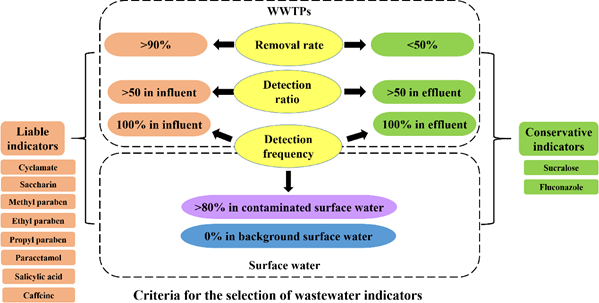
Wastewater indicators are useful tools for monitoring domestic sewage contamination in the aquatic environment. Hitherto, various wastewater indicators for have been proposed, such as microorganism (e.g. fecal coliforms), inorganic elements (e.g. chloride and bromide) and stable isotope ratio (e.g. δ15N). However, there is a lack of source specificity for these indicators, which has limited their use as wastewater indicators. Professor Ying’s group proposed pharmaceuticals and personal care products (PPCPs) and artificial sweeteners (ASs) as better domestic wastewater indicators. They investigated the occurrence and removal efficiencies of 98 wastewater related organic chemicals (93 PPCPs and 5 ASs) in wastewater treatment plants (WWTPs) located in the Pearl River Delta region, and the occurrence of these target compounds the surface water of the Pearl River. Moreover, they developed a set of criteria for selecting wastewater indicators based on the removal efficiencies in WWTPs, detection frequencies and detection ratio (the ratio between the median concentration of a compound and its limit of quantification in different matrices) in effluents and influents of WWTPs and surface water and physicochemical properties of the target compounds. Finally, sucralose, fluconazole, methyl paraben, ethyl paraben, propyl paraben, paracetamol, salicylic acid and caffeine were selected as wastewater indicators in the aquatic environment. They further investigated the occurrence of the above 98 chemicals in the surface water and groundwater of Dongjiang River basin, and proved that sucralose can be used as wastewater indicator to evaluate the impact by wastewater in surface water and groundwater qualitatively and quantitatively. The chemical sucralose can be used to calculate wastewater burden in surface water and groundwater. The results can assist relevant agencies to better understand domestic sewage contamination in surface water and groundwater, and make scientific decision to control pollution.
These works have been published on the Journal of Science of the Total Environment:
Publications: